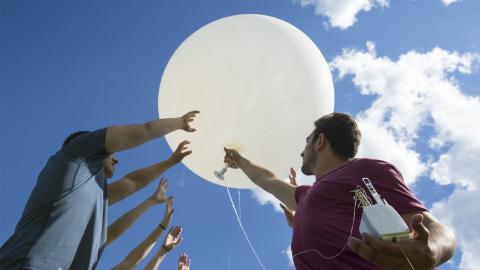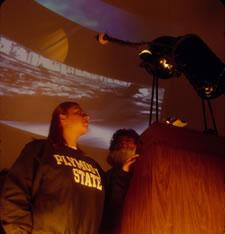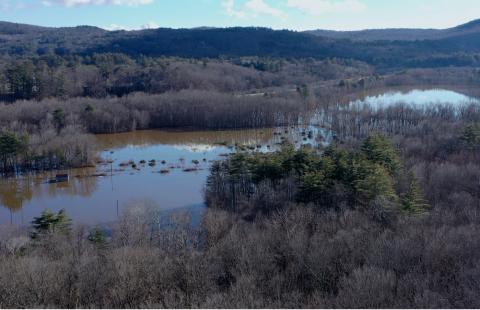A unique program in our state and nation.
Our faculty are experts in a variety of areas, and are involved in a variety of nationally and regional work in the discipline. Our graduates go on to traditional jobs in the field such as National Weather Service forecasters and TV meteorologists, or continue on to graduate school, but also go on to jobs in a wide variety of areas such as emergency management, consulting services of many kinds, teaching, and many other government and private industry careers.
We are a supportive community with faculty that are present and care about students, and with students who are responsible and excited about what they do and who help each other. We are also proud to have excellent facilities, and to provide many opportunities for students to participate in a large variety of hands-on experiences, conference travel, and much more.
The nationally recognized Plymouth State Meteorology program is one of very few in New England and the only one in New Hampshire. It offers students not only a high-quality curriculum in traditional and applied areas of meteorology and atmospheric science, but also a variety of experiential courses that include broadcast TV, weather seminar, research, internship opportunities, and others. The depth and versatility of the education received by graduates of this program allow them to either pursue advanced graduate study, or seek employment in the variety of operational and applied employment opportunities in meteorology and related fields, including in the rapidly growing private sector.
Curriculum & Requirements
| Course | Title | Credits |
|---|---|---|
| Major Requirements | ||
| MT 1000 | Introduction to Weather Community | 1 |
| MT 2000 | Fundamentals of Meteorology and Climatology (GACO) | 3 |
| MT 2250 | Introduction to Weather Analysis and Forecasting | 4 |
| MT 3230 | Atmospheric Thermodynamics | 3 |
| MT 3725 | Instruments and Observations in Meteorology | 3 |
| MT 4280 | Synoptic Meteorology (TECO) | 4 |
| MT 4310 | Dynamic Meteorology I | 3 |
| MT 4320 | Dynamic Meteorology II | 3 |
| MT 4410 | Atmospheric Physics | 3 |
| MT 4460 | Climate Dynamics | 3 |
| MT 4480 | Mesoscale Meteorology | 3 |
| MT 4725 | Meteorological Remote Sensing (WRCO) | 3 |
| Capstone Experience | ||
| Complete 6 credits from the following list: | 6 | |
MT 4155 | Air Quality | |
MT 4405 | Numerical Weather Prediction (TECO) | |
MT 4425 | Tropical Weather and Climate | |
ESP 4441 | Climate Change | |
MT 4560 | Topics in Meteorology | |
MA 3600 | Differential Equations with Linear Algebra | |
| Complete 2 credits from the following list of courses | 2 | |
MT 4000 | Meteorology Seminar | |
MT 4264 | Broadcast Meteorology | |
MT 4360 | Forecasting/Broadcast Practicum | |
MT 4500 | Undergraduate Research | |
MT 4600 | Internship | |
MT 4910 | Independent Study | |
| Prerequisite Topics in Mathematics and Physical Sciences | ||
| CH 2335 | General Chemistry I (QRCO) | 4 |
| Programming (Complete one CS course or both GE courses) | 3-8 | |
CS 2400 | ||
or CS 2370 | Introduction to Programming | |
GE 2050 | GIS I: Introduction to Geographic Information Systems (QRCO,TECO) | |
GE 4060 | GIS Programming | |
| MA 2550 | Calculus I (QRCO) | 4 |
| MA 2560 | Calculus II (QRCO) | 4 |
| MA 3500 | Probability and Statistics for Scientists | 3 |
| or MA 2300 | Statistics I (QRCO) | |
| MA 3540 | Calculus III | 4 |
| PH 2510 | University Physics I | 4 |
| PH 2520 | University Physics II | 4 |
| General Education | ||
| EN 1400 | Composition | 4 |
| IS 1115 | Tackling a Wicked Problem | 4 |
| CTDI | Creative Thought Direction | 3-4 |
| PPDI | Past and Present Direction | 3-4 |
| SSDI | Self and Society Direction | 3-4 |
| Directions (choose from CTDI, PPDI, SSDI) 1 | 7-4 | |
| DICO | Diversity Connection | 3-4 |
| INCP | Integrated Capstone | 4 |
| WECO | Wellness Connection | 3-4 |
| Electives | 5-12 | |
| Total Credits | 120 | |
- 1
Directions should total 16 credits because the Scientific Inquiry Direction (SIDI) is waived for BS Meteorology students.
Path to a 4+1 BS and MS
Undergraduate students that reach senior status with a cumulative GPA of at least 3.0 may be able to complete the BS degree and earn their MS Applied Meteorology degree with one additional year of study. Students interested in completing both degrees in five years will consult with their academic advisor and choose to enroll in six credits of graduate courses (e.g., MT 5200 Transportation Meteorology) and will be advised to enroll in MT 4500 Undergraduate Research to fulfill their Capstone Experience. Students will apply to the graduate program during their last year of undergraduate study. If admitted and after earning their BS degree, students will complete 24 credits of graduate work during the following year. For example, students may enroll in four credits of graduate courses during the summer term after earning their BS and 20 credits of graduate courses during the following academic year.
Check all course descriptions for prerequisites before planning course schedule. Course sequence is suggested but not required.
To complete the bachelor’s degree in 4 years, you must successfully complete a minimum of 15 credits each semester or have a plan to make up credits over the course of the 4 years. For example, if you take 14 credits one semester, you need to take 16 credits in another semester. Credits completed must count toward your program requirements (major, option, minor, certificate, general education or free electives).
| Year One | Credits | |
|---|---|---|
| MT 1000 | Introduction to Weather Community | 1 |
| MT 2000 | Fundamentals of Meteorology and Climatology (GACO) | 3 |
| MT 2250 | Introduction to Weather Analysis and Forecasting | 4 |
| CH 2335 | General Chemistry I (QRCO) | 4 |
| IS 1115 | Tackling a Wicked Problem | 4 |
| MA 2550 | Calculus I (QRCO) | 4 |
| MA 2560 | Calculus II (QRCO) | 4 |
| EN 1400 | Composition | 4 |
| CTDI | Creative Thought Direction | 3-4 |
| Credits | 31-32 | |
| Year Two | ||
| MT 3230 | Atmospheric Thermodynamics | 3 |
| MT 3725 | Instruments and Observations in Meteorology | 3 |
| MA 3500 or MA 2300 |
Probability and Statistics for Scientists or Statistics I (QRCO) |
3 |
| MA 3540 | Calculus III | 4 |
| PH 2510 | University Physics I | 4 |
| PH 2520 | University Physics II | 4 |
| PPDI | Past and Present Direction | 3-4 |
| SSDI | Self and Society Direction | 3-4 |
| WECO | Wellness Connection | 3-4 |
| Credits | 30-33 | |
| Years Three and Four | ||
| MT 4725 | Meteorological Remote Sensing (WRCO) | 3 |
| MT 4280 | Synoptic Meteorology (TECO) | 4 |
| MT 4310 | Dynamic Meteorology I | 3 |
| MT 4320 | Dynamic Meteorology II | 3 |
| MT 4410 | Atmospheric Physics | 3 |
| MT 4460 | Climate Dynamics | 3 |
| MT 4480 | Mesoscale Meteorology | 3 |
| MT | Complete 8 credits from a Capstone Experience | 8 |
| Programming | 3-8 | |
| Directions (choose from CTDI, PPDI, SSDI) 1 | 7-4 | |
| DICO | Diversity Connection | 3-4 |
| INCP | Integrated Capstone | 3-4 |
| Electives | 5-12 | |
| Credits | 51-62 | |
| Total Credits | 120 | |
- 1
Directions should total 16-17 credits because SIDI is waived for BS Meteorology.
- Explain meteorological phenomena at various scales in terms of basic physical and dynamic process including radiative forcing, thermodynamics, microphysics, electricity, and optics.
- Plot, analyze and interpret weather maps, charts, and meteorological diagrams.
- Explain the design, strengths, weaknesses, and use of observational systems.
- Produce and explain short- and medium-term weather forecasts based on sound meteorological principles.
- Derive and interpret equations that describe atmospheric motions and dynamic processes for various spatial and temporal scales.
- Explain climate phenomena including global circulations, past and current climate, and basic physical mechanisms, responsible for climate change.
- Apply mathematical and statistical techniques to Earth systems data through scientific programming and meteorological software packages.
- Explain scientific ideas, results, and weather information through written and oral communication to technical and general audiences.
- Integrate and use meteorological knowledge and techniques in real-world applications.
- Air Quality Engineer
- College Professor
- Environmental Consultant
- Flight Director
- Forensic Meteorologist
- Instrumentation Specialist
- Meteorologist
- Physicist
- Risk Manager
- Technical Writer
- Broadcast Meteorologist
- Ability to analyze cause and effects
- Proficiency in analytical reasoning
- Strong mathematical background
- Ability to organize and memorize detailed information
- Strong organization skills
Explore Program Details
Electronic Mapwall

The electronic mapwall at Plymouth State provides meteorology students a unique platform to visualize a wide variety of atmospheric phenomenon. Students are able to use the wall to analyze a wide variety of surface & upper air data observations, radar & satellite imagery, and numerical weather prediction model forecast parameters.
Consisting of eight 48 inch HD monitors, the map wall is capable of displaying any type of digital content. Students can use the mapwall as a canvass for designing their own interactive multimedia weather discussions. With a combined resolution of 7680 by 2048 pixels, the map wall allows for enhanced viewing of high resolution imagery from NASA, NOAA, and other sources.
Radiosonde Instrumentation

A radiosonde is a small instrument package tethered to a weather balloon. Radiosondes take a vertical profile of the atmosphere as the balloon ascends to altitudes up to 115,000 feet. The data is relayed by radio transmitter to a computer at the surface.
Each radiosonde measures atmospheric pressure, air temperature, dew point/humidity, and wind velocity. Additionally, radiosondes can be equipped with ozone and radiation sensors.
Students launch radiosondes as part of their coursework and when performing research. Students are also involved in educating the public about radiosondes during science fairs and open houses located across New England.
AWOS: Automated Weather Observing System

Located about four miles from campus, the Automated Weather Observing System (AWOS) at Plymouth Municipal Airport (K1P1) provides students, pilots, and other interested users with current weather information. The AWOS is a 30-foot steel tower containing a series of instruments designed to measure and record many meteorological variables. The system at K1P1 is an AWOS III-PT and has the ability to measure variables including wind speed, wind gust, wind direction, temperature, dew point, altimeter setting, visibility, precipitation, day/night, cloud height, sky condition, present weather, and lightning detection. These data are used by meteorologists, pilots, and flight dispatchers to monitor the weather conditions and provide essential information for flight takeoff and landing procedures.
Data collected by the AWOS at K1P1 are available to the public via radio, phone, and internet. Students at Plymouth State University use the AWOS as a source of up-to-date weather information that can be used in weather discussions and to make forecasts for Plymouth and the surrounding area. Also, students enrolled in the meteorology program learn about each of the sensors on the AWOS and are shown how the data is collected, processed, and distributed to the public.
The station is officially known as the Joseph Zabransky Weather Observation Station, which honors the emeritus professor for his nearly 25 years of service to Plymouth State. Dr. Zabransky had a great passion for meteorological instrumentation and was responsible for establishing the AWOS in 2005.
The Judd Gregg Meteorology Institute (JGMI) is a center for applied atmospheric science research and outreach focused on serving and educating the New England region to provide knowledge that improves people’s lives. Through a diversity of expertise, faculty and staff work independently and in collaboration with partners to address real-world weather and climate issues. Current expertise includes synoptic, mesoscale, and tropical meteorology, atmospheric physics, and other practical and applied areas such as boundary-layer and coastal meteorology, air quality, extreme precipitation, remote sensing, air-sea interaction, climatology, paleoclimatology, transportation meteorology, and historical meteorology. Members of the institute engage in data analysis, field studies, and numerical modeling on multiple scales utilizing a wide array of instrumentation and technology. As part of Plymouth State University, JGMI faculty and staff are committed to educational excellence in both the undergraduate and graduate meteorology degree programs. JGMI activities regularly involve students, providing graduates with a strong foundation in atmospheric science and preparing them for diverse range of careers.
JGMI resources and outreach opportunities include:
- The Plymouth State Weather Center, one of the most sophisticated college or university weather centers in the country. It provides comprehensive weather information, including observations, tutorials, satellite and radar data, and more.
- The Weather Center Website, which is accessed more than 500,000 times a week.
- Research facilities for undergraduate and graduate meteorology students, including a rooftop weather observation center, electronic map wall, weather technology lab, GPS-radiosonde system, a portable micrometeorological measurement platform, and a fully instrumental Automated Weather Observation System (AWOS).
- Projects and partnerships with the National Weather Center, University of New Hampshire, National Oceanic and Atmospheric Administration, U.S. Air Force, National Center for Atmospheric Research, Federal Aviation Administration, Mount Washington Observatory, U.S. Army Cold Regions Research Engineering Laboratory, and many other agencies.
- Online archive of meteorological data used to analyze air chemistry and pollution events.
- A 10-year agreement with the New Hampshire Department of Transportation to deploy over 50 weather observation stations throughout the state to measure road surface and subsurface temperature and ozone concentrations.
- Workshops for K-12 teachers and institute field trips for students.

Mark Sylvestre Planetarium
The Mark T. Sylvestre Planetarium in Boyd Science Center offers programs for local K-12 schools and the general community. These programs are presented by Planetarium Director Dr. Brad Moser, Plymouth State students, and NASA Solar System Ambassador Sally Jean Jensen. Shows will feature recent topics in astronomy news and a guided sky tour for the current season.
The 31-seat, 20-foot dome facility features:
- StarLab LED Sky Projector
- LCD project for slideshow presentations
- High quality sound system
- Accessible entrance for visitors with disabilities
Educators should reach out directly to the planetarium director for inquiries regarding school visits. General programming for the public will commence late fall 2023 or early winter 2024. Stay tuned for additional information.
Contact Dr. Moser at bradley.moser@plymouth.edu for further information.
Explore Today.
Realize Tomorrow.











